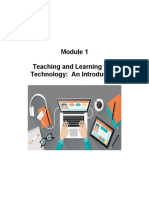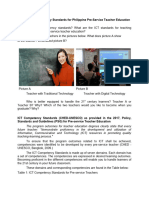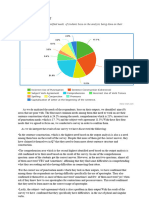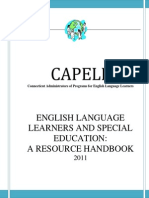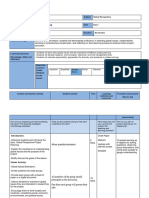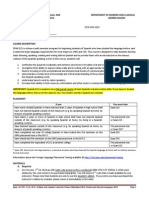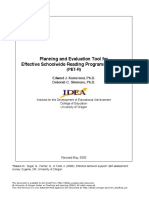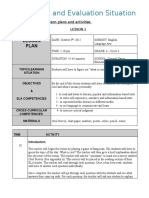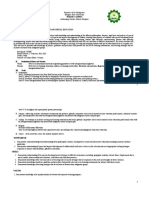SAINT JOSEPH COLLEGE of SINDANGAN INCORPORATED
Sindangan, Zamboanga del Norte, Philippines
Telefax No. (065) 224-2710/ +639121561506
Technology for Teaching and Learning
Prelim MODULE 1
LESSON 1: ICT Competency Standards for Philippine Pre-
Service Teacher Education
Learning Outcomes:
1. Identified the competency Standards of ICT necessary in teaching for pre-service teacher
education.
2. Familiarized with ISTE National Educational Technology Standards for Teachers.
Reference/s: Bilbao, Dequilla, Rosano, Boholano (2019). Technology for Teaching and Learning 1. LORIMAR
Publishing Inc. pp. 1 - 9
Week : 1
Time Duration : 3 hours (1 hour Face to Face Class, 2 hours Modular - per Week)
Activating Prior Knowledge:
Teacher with Traditional Technology Teacher with Digital Technology
1. Who is better equipped to handle the 21st century learners? Why?
2. Which of the two teachers would you like to become when you graduate? Why?
Essential Ideas
ICT Competency Standards (CHED-UNESCO) as provided in the 2017, Policy, Standards and Guidelines
(PSG) for Pre-Service Teacher Education
The program outcomes for teacher education degrees clearly state that every future teacher: demonstrate
proficiency in the development and utilization of Information, Communication and Technology (ICT) resources in
promoting quality teaching-learning process.”
To ensure that the program outcomes related to IcT shall be achieved, competencies were identified to be
developed by every pre-service teacher (CHED-UNESCO, Bangkok, 2009.)
The ICT Competency Standards is made up of seven domains. Each domain has a set of competencies.
The competencies are expressed in desired learning outcomes. Becoming proficient in the different competencies
will enable you to handle learners of the 21st century in your future classroom.
These domains and corresponding competencies are found in the Table below:
1
�ICT COMPETENCY STANDARDS FOR PRE-SERVICE TEACHERS
Domain 1 : Understanding ICT in Education
1.1 Demonstrate awareness of policies affecting ICT in education
1.2 Comply with ICT policies as they affect teaching-learning
1.3 Contextualize ICT policies to the learning environment
Domain 2 : Curriculum and Assessment
2.1 Demonstrate understanding of concepts, priciples and theories of ICT systems as they apply to teaching-
learning
2.2 Evaluate digital and non-digital learning resources in response to student’s diverse needs
2.3 Develop digital learning resources in response to enhance teaching-learning
2.4 Use ICT tools to develop 21st century skills: information media and technology skills , career skills and
effective communication skills
Domain 3: Pedagogy
3.1 Apply relevant technology tools for classroom activities
3.2 Use ICT knowledge to solve complex problems and support student collaborative activities
3.3 Model collaborative knowledge construction in face to face and virtual environments
Domain 4: Technology Tools
4.1 Demonstrate competence in the technical operations of technology tools and systems as they apply to teaching
and learning
4.2 Use technology tools to create neww learning opportunities to support community of learners
4.3 Demonstrate proficiency in the use of technology tools to support teaching and learning
Domain 5: Organiation and Administration
5.1 Manage technology-assisted instruction in an inclusive classroom environment
5.2 Exhibit leadership in shared decision-making using technology tools
Domain 6: Teacher Professional Learning
6.1 Explore existing and emerging technology to acquire additional content and pedagogical knowledge
6.2 Utilie technology tools in creating communities of practice
6.3 Collaborative with peers, colleagues and stakeholders to access information in support of professional learning
Domain 7: Teacher Disposition
7.1 Demonstrate social, ethical, and legal responsibility in the use of technology tools and resources
7.2 Show positive attitude towards the use of technology tools
Likewise, the Department of Education issued Department of Education Order 42, s. 2017 mandating the
use of of the Philippine Professional Standards for Teachers (PPST) to start with the Beginning Teachers who are
the fresh graduates from the teacher education program. The document includes:
Show skills in the positive use of ICT to facilitate teaching and learning and
Show skills in the selection, development and use of the variety of teaching learning resources including ICT to
address learning goals.
These competency standards to learn and master will assure the 21st century learners in your classof a
more enjoyable, creative, innovative ways in teaching and learning.
ISTE NATIONAL EDUCATIONAL TECHNOLOGY STANDARDS FOR TEACHERS (NETS* T)
An international organization for educational technology called International Society for Technology in
Education (ISTE) , established standards for both teachers and students. These standards were also referred to in
the development of Philippine ICT Competency standards which include the following:
Standard 1: Technology Operations and Concepts
This means that teachers demonstrate a sound understanding of technology operations and concepts.
Stardard 2 : Planning and Designing Learning Environment and Experiences
This standard implies that teachers utilizethe use of technology to plan and design effective learning
environments and experiences.
Standard 3: teaching, Learning and Curriculum
Teachers should be mindful that in the implementation of curriculum plan, they have to include strategies
for applying technology to maxi,ize student learning.
Standard 4 : Assessment and Evaluation
Teachers apply technology to facilitate a variety of effective assestment and evaluation strategies to
collecct and analye data, interpret results, and communicate findings to improve instructional practice and
maximize student learning.
Standard 5 : Productivity and Professional Practice
Teachers use technology to engage in on-going professional development and lifelong learning in support
of student learning, increase productivity and to build community of learners.
Standard 6 : Social, Ethical, Legal and Human Issues
2
� Teachers understand the social, ethical , legal and human issues surrounding the use of technology in
support of student learning who come from diverse background , affirm diversity, promote safe and
healthy use of technology resources and facilitate access to technoloy resources for all students.
Likewise, ISTE also developed standards needed for students. These standards will be used as a guide by
teachers to plan technology-based activities in which students achieve success in learning, communication and life
skills.
ISTE National Educational Technology Standards for Students (NETS* S)
From how technology teachers facilitate learners, outcomes of student learning should indicate that the
following standards have been complied with.
Standard 1 : Creativity and Innovation
This standard will produce students who demonstrate creative thinking, construct knowledge, develop
innovative products and process using technology from existing knowledge.
Standard 2 : Communication and Collaboration
This standard requires students to use digital media and environments to communicate and work
collaboratively to support individual learning and contribute to the learning of others. This includes the
use of variety of media and formats for global awareness with learners from other cultures.
Standard 3 : Research and Information Fluency
Students are expected to apply digital tools to gather, evaluate and use information and plan strategies for
inquiry. This standard expects the student to locate, organize, analyze, evaluate, synthesie and ethically
use information from a variety of sources and media.
Standard 4: Critical Thinking, problem-Solving and Decision Making
This standard expects the students to use critical skills to plan and conduct research, manage projects,
solve problems and make informed decisions using appropriate digital tools.
Standard 5 : Digital Citizenship
It is required by this standard that every technology student becomes a digital citizen who demonstrates
ethical and legal behavior, exemplified by the practice of safe, legal and responsible use of information.
Further, the student exhibits positive attitude towards the support of technology for collaboration, learning
and productivity as a digital citizen.
Standard 6 : Technology Operations and Concepts
Sound understanding of technology concepts, systems and operation is a standard that students should
comply with. They too, are expected to further trasfer current knowledge to learnning of new
technologies.
As pre-service teacher education students now, you will have to master the knowledge and skills
(Learning to Know) for the satandards for students. However since you will become teachers in the future, yu
should harness the same knowledge and skills to become (Learning to Become) future teachers.
II. Learning Experiences
A. Clarifying Understanding
A. In this lesson,
1. I learned that ... (Knowledge)
2. I felt that ... (Value/Attitude)
3. I developed ... (Skill)
B. Choose the best answer from the options given:
1. The ICT competency standards for teachers include all the following EXCEPT one. Which one?
A. digital and non-digital technology
B. enhance financial literacy skills
C. ethical issues on the use of ICT
D. use of technology tools
2. All teachers in the 21st century should be .
A. digital citizens C. Digital immigrant
B. digital natives D. Digital police
3. The use of technology will enhance the 21st century skills along
I. development of tools
II. critical thinking and problem solving
III. designing learning environment and spaces
IV. all of the above
3
� A. I only B. II only C. I,II,III D. IV only
4. A universal standard in the use of ICT in teaching and learning in the classroom requires all teachers to
EXCEPT one.
A. use gadgets when teaching
B. understand the issues and safety policies
C. utilie the tools available in the enviroment
D. buy an expensive computer
5. One of the constraints in the application of ICT for the enhancement of standards among teachers and students
is .
A. training of technology teachers
B. connectivity of the school
C. availability of qualified teachers
D. lack of awareness about the use of technology
Prepared by:
Ronali Asonda Tansico, LPT
Subject Teacher












